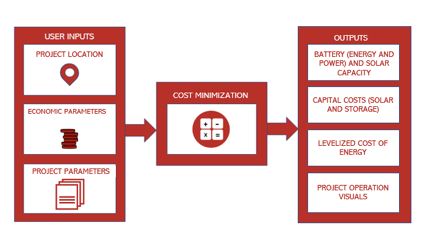Methodology
Methodology
This solar PV plus storage sizing tool aims to estimate the least-cost optimal size (MW/MWh) of a hybrid solar plus storage plant that meets the generation requirements for two applications: solar energy output smoothing and shifting to deliver a user-defined demand profile. This solar PV plus storage sizing does not replace the comprehensive project sizing and design of hybrid solar plus storage projects.
Using a linear programing solver, the application minimizes the annualized investment costs for the hybrid solar plus storage system, including the unserved load, by optimally dimensioning the solar PV and BESS. The linear program is subject to a number of constraints modeling the physical behavior of the system, including the efficiencies of the different elements.

For the smoothing application, the user provides the smoothing time step. This value reflects the number of hours during which the hybrid solar PV plus storage system will provide a constant output. For example, if the smoothing time step is 2 hours then the solar PV plus storage system’s output will be a stepwise function with a 2-hour step.
For the shifting application, the user provides the hourly demand profile and the hourly value of non-served energy (peak demand hours may have a higher value). The hybrid solar PV plus BESS system is optimized considering the demand and the value of unserved energy.
The solution is a minimization of the objective function:
Total Cost = Annual Solar Plant Cost + Annual BESS Energy Cost + Annual BESS Power Cost + Unserved Energy Cost
The solution is constrained by a set of linear constraints that describe the bounds of the solution over time steps corresponding to the solar profile.
For each time step:
0 <= BESS Input <= Solar Generation, BESS Power Capacity
0 <= BESS Output <= BESS Power Capacity
Minimum State of Charge <= BESS State of Charge <= BESS Energy Capacity
BESS State of Charge[n+1] = BESS State of Charge[n] + BESS Input - BESS Output * Round Trip Efficiency
Solar Generation - BESS Input + (BESS Output * Round Trip Efficiency) + Unserved Energy = Demand
The output includes the following time series across the year:
Load Served from Solar: Generation output of the solar PV component
Load Served from BESS: Output served from the Battery component
Solar Output: solar resource output data from the Global Solar Atlas
Served Energy: The output of the PV + BESS plant
BESS discharge per hour (in MW): Discharging of BESS for each time period
BESS charge per hour (in MW): Charging of BESS for each time period
BESS Stored Energy (in MW): State of charge of BESS for each time period
Unserved energy (in MW): Energy that must be served by other means